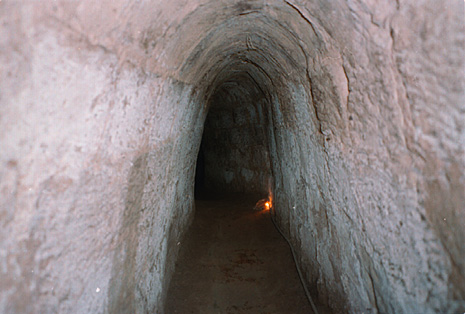50 kilometers of tunnels? Boy, that is an interesting factor for the ground campaign for Israel. Obviously Hamas has been studying tunnels and preparing the battlefield. And like what this great little article talks about, Hamas has learned what they can from Hezbollah and their experiences and they are ready to go.
But back to tunnels. When I think tunnels and warfare, I think of the Cu Chi tunnel complex used during the Vietnam War. Sure there are other famous uses of tunnels in warfare, but the Vietnamese were pretty crafty in this department. Hamas has used their tunnels to smuggle weapons into Gaza, to cross borders to infiltrate martyrdom teams, and set up rocket launching sites that are connected by tunnels for safe launching and easy escape. Of course the launch sites would be set up in civilian areas, to maximize civilian casualties for the retaliatory attacks that would soon follow.
Another use for these tunnels will be for urban warfare. It is quite a thing to fight an enemy that knows how to effectively use tunnels. If the things are deep enough, none of these air strikes will touch them. Hamas can also plant IED’s via tunnels, so they can take out tanks and other vehicles. I also imagine that much of their munitions are deep underground as well. And like the Vietnamese, Hamas makes their own munitions as well. If they have the ability to launch 200 rockets a day, that means they have a very accelerated and advanced manufacturing and smuggling operation going on.
So what does this mean for the Israelis? Time to break out the flashlights, pistols, and the camera robots, and get underground to clear these things. That’s if they can find all of these tunnels. It will take careful searches to find these things, and rear security could be an issue. Perhaps ground penetrating radar will be used, and I am sure tunnels will be just one of the multitude of concerns that the Israelis will have for the ground invasion. –Matt
——————————————————————-

Mai Chi Tho, a political commissar stationed in Cu Chi describes the region as a “springboard for attacking Saigon.” He goes on to say: “We used the area for infiltrating Saigon-intelligence agents, part cadres, sabotage teams. The Tet Offensive of 1968 was prepared and the necessary troops and supplies assembled in the Cu Chi tunnels.” By 1965, there were over 200 kilometers of connected tunnel.
Analysis: The Hamas army
Dec. 27, 2008
Yaakov Katz , THE JERUSALEM POST
Hamas, once known for its suicide attacks inside Israeli cities, is no longer a small-time terrorist group, but a large guerrilla army that has well-trained forces deployed throughout the entire Gaza Strip.
Were the IDF to embark on a ground operation in Gaza, it would face an army of close to 20,000 armed men, among them at least 15,000 Hamas operatives. The rest are from Islamic Jihad, the Popular Front for the Liberation of Palestine and the Popular Resistance Committees.
Since the cease-fire went into effect in Gaza in June, Hamas has used the lull in action to fortify its military posts in the Strip and dig tunnel systems as well as underground bunkers for its forces. IDF estimates put the length of the tunnels at over 50 kilometers.
Hamas has also dug foxholes throughout the Strip to accommodate anti-tank missile units, and prepared massive bombs, which have been placed on the main access roads into Gaza.
In addition to its homemade Kassam rockets, Hamas has smuggled into Gaza a number of anti-aircraft cannons and several shoulder-to-air missiles. It also a large number of anti-tank missiles that, if used correctly, could wreak havoc on Israeli armor in the event of a ground operation involving tanks and armored personnel carriers.
It also has Special Forces – commando forces and units with expertise in rocket fire, mortar attacks and roadside bombs.
“Hamas has learned a lot from Hizbullah and has adopted many of the Lebanese group’s tactics which were used successfully against the IDF in the Second Lebanon War,” one IDF official said.
Since Israel’s unilateral disengagement from the Gaza Strip in the summer of 2005, Hamas has created a military with a clear hierarchy, led by Hamas “chief” Ahmed Ja’abri.
Ja’abri is in his late 40s and has been in Israel’s sights for a number of years. In 2004, Israel Air Force jets fired several missiles at Ja’abri’s home in the Sajiya neighborhood of Gaza City. Ja’abri escaped the assassination attempt with moderate wounds. Five others were killed.
Since then, he has slowly climbed the Hamas ranks and today is believed to be the terror group’s so-called “chief of staff,” replacing arch-terrorist Muhammad Deif, who was seriously wounded in an Israeli air strike in July 2006.
Hamas has split the Gaza Strip into five sections corresponding to five different brigades in the north, center, Gaza City, and two brigades in the south. Each brigade has a commander as well as several battalions under its command.
Ja’abri is commander of Gaza City. Ahmed Andour is in charge in the north. Iman Nufal, commander of central Gaza, is in Egyptian custody after he was arrested last year entering the Sinai Peninsula. There are also two brigades in the south – one in Khan Yunis and one in Rafah. The commanders there are Mahmoud Sanour and Ra’ad Alatour, respectively.
Andour is believed to be Ja’abri’s right-hand man and the two were behind the attacks against Fatah militiamen in the summer of 2007 that led to Hamas’s takeover of the Gaza Strip. Ja’abri and Andour are also believed to have masterminded the June 2006 kidnapping of Gilad Schalit.
IDF sources said Saturday that it was likely that several senior Hamas operatives and commanders were killed in Saturday’s air strike.
Story Here